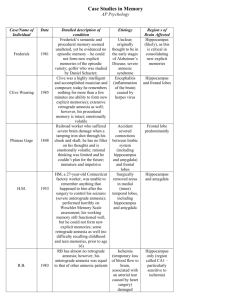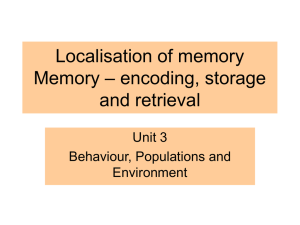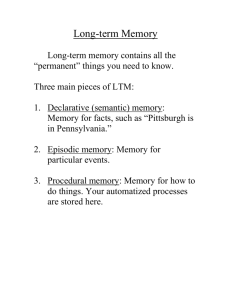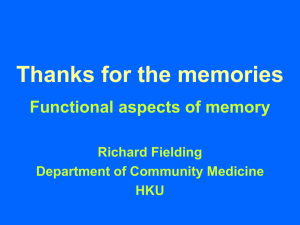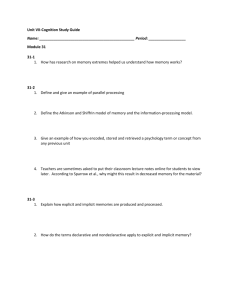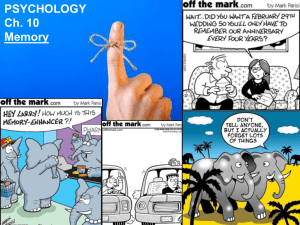presentation source
advertisement
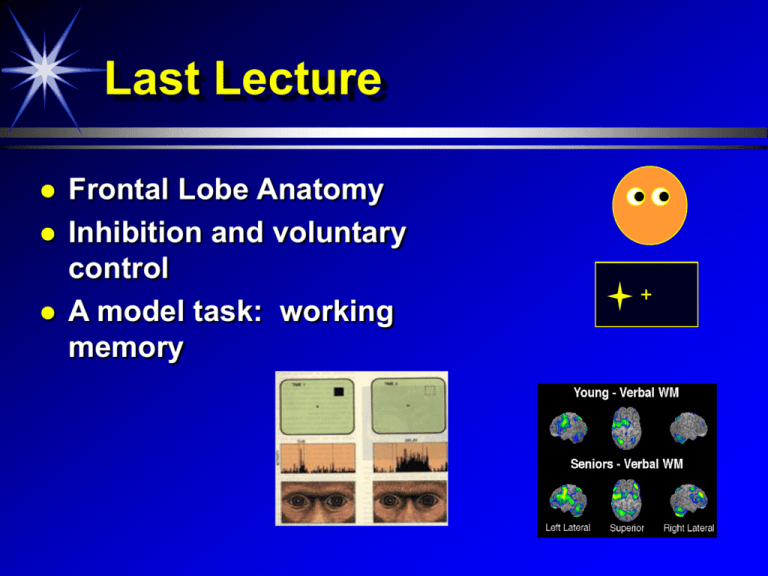
Last Lecture Frontal Lobe Anatomy Inhibition and voluntary control A model task: working memory + This Lecture Long Term Memory role of hippocampus in consolidation role of frontal regions in encoding and retrieval right frontal regions and representation of self... Announcements FINAL EXAM: 182 Dennison Wednesday, 4/19 4:00 pm - 6:00 pm. Please contact us immediately if this poses a conflict. Long Term Memory and its Dysfunction Memory: the ability to retain & recollect the contents of our experience typically multimodal rich in associations The ability to acquire new skills & demonstrate improved performance as a result of experience. Human Amnesia Anterograde: Inability to acquire NEW memories. Retrograde: Inability to recollect OLD memories. Human Amnesia Scoville & Milner (1957) H.M. bilateral removal of hippocampus (medial temporal lobes). Wada testing to avoid bilateral hippocampectomies. Unilateral removals: material-specific deficit: (Right- nonverbal; Left: verbal) Case H.M.-- PROFOUND ANTEROGRADE AMNESIA High Average intelligence STM: normal- digit span 7 forward; 5 backward Can converse normally, perform mental math No post-operative personality changes Unable to acquire new memories... all modalities all material (verbal, nonverbal) names, people, places, events, route finding all are affected. Early animal models of HM were unsuccessful WHY? (Hint: remember what happened with blindsight) Testing the wrong type of memory What Amnesics can learn: Milner (1962) mirror drawing Warrington & Weiskrantz (1968) perceptual learning (degraded cues, priming) Weiskrantz & Warrington (1979) classical conditioning Types of Long Term Memory Declarative/Explicit consciously accessible Episodic: personal/public episodes Semantic: facts, events, routes Tested with recall / recognition: "Have you seen this before?"; "Can you remember...?"; "Is this one of the items you studied...?” Nondeclarative/Procedural/Implicit Does not require conscious recollection Examples: conditioning skills (motor skills, mirror reading) priming (e.g. stem completion) Skill Acquisition Mirror drawing improves Amnesics = Controls An example of the dichotomy... Phase 1 Phase 2 Read & rate words (living/non): Lead Bear Fear Work... EXPLICIT TEST: "Complete stem with a word you just read" lea_ bea_ OR IMPLICIT TEST: "Complete stem with first word that comes to mind" lea_ ---> lead or leaf bea_ ---> beat or bear Priming is spared in Amnesia Amnesics cannot recall study items. But stored representation is accessed automatically. 80 70 60 50 40 Controls Amnesics 30 20 10 0 Cued Recall Fill-in The Hippocampal circuit & Explicit Memory Hippocampus - part of a circuit with input to & from parietal, temporal, frontal lobes & limbic system (amygdala). Hippocampus The Hippocampal circuit & Explicit Memory Hippocampus - part of a circuit with input to & from parietal, temporal, frontal lobes & limbic system (amygdala). CA1 , CA2 , CA3 layers of HPC form a circuit allowing access to cortex CA1 layer - sensitive to anoxia & epileptic activity (CASE R.B.) Damage to HPC or its inputs/outputs --> LTM impairment Role of Hippocampus in Explicit Memory NOT the location of LTM NOT necessary for retrieval of LTM NOT the location of STM HPC: immediate experience --> LT memories CONSOLIDATION Explicit memory - stores single events w/ context. Learning is fast (one-trial learning-- but forgetting endures). Representations are accessible by various cognitive systems modality-general give rise to sense of familiarity. Implicit memory... Reactivation of the processing structures engaged during learning. Learning is incremental, gradual, slow Representations are specific to a task and or the learning modality. Involves multiple systems (cortex, basal ganglia) More on the encoding and retrieval of explicit LTM... Frontal Contributions to LTM Recency Judgments knowledge of temporal context give a list of items probe w/ two items asking: “Which one of these items came most recently?” Frontal Contributions Source Memory ability to identify (remember) the context in which a memory was acquired task: judge which of two characters uttered a particular fact. Mt. Everest Keeps growing 90 80 Controls Frontal 70 60 50 40 30 20 10 0 True/False Psyd/Hypno Marco Polo was Venetian HERA: Hemispheric Encoding/Retrieval Asymmetry (Tulving et al., 1994) PET studies w/normal subjects show Left Hem. is critical to encoding into LTM Lateral Prefrontal areas all materials: verbal & nonverbal Why? associating meaning with events Right Hem. is critical to retrieval from LTM Lateral Prefrontal areas all materials: verbal & nonverbal Why? memory requires reflection about self / personal experience Right Frontal Lobe & Self Craik et al., 1999 - PET study with 4 conditions How well does the word stubborn describe... You? Lee Bollinger? How socially desireable? How many syllables? RESULT: Only self-referential instruction activated Right prefrontal cortex ( same areas activated by memory retrieval) Conclusion: Right frontal regions are important for representation of self. Memory Summary WM vs. LTM Explicit (personal episodes, semantics/facts) Amnesia -- anterograde or retrograde Establishing new explicit memories requires LTM: IMPLICIT vs. EXPLICIT encoding, consolidation, retreival hippocampus -- consolidation (HM & RB) HERA: Left frontal- encoding (context info) Right frontal- retrieval (self)

